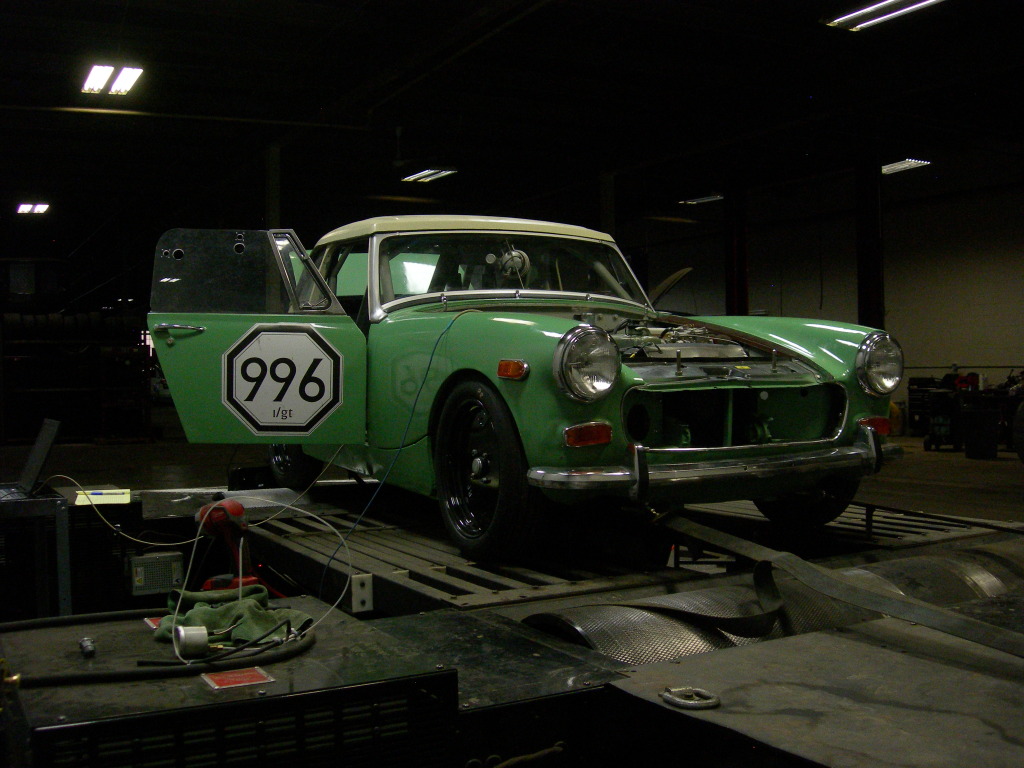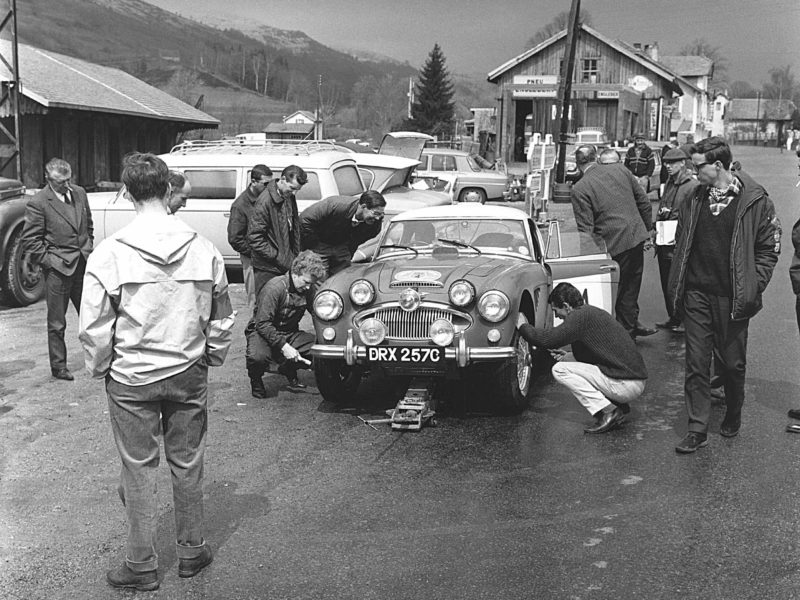A while back, I wrote up an article about my plans to race an MG Midget in the I/GT class at the Bonneville Salt Flats in September, 2012. The plan was to campaign the “Milwaukee Midget” at the World of Speed event, which is run by the Utah Salt Flats Racing Association.
Without going into the ghastly details, my plan to compete was waylaid by numerous work scheduling difficulties and slow suppliers. The only option left to me was the last event of the year, the World Finals, which is held during the first full week of October.
I finagled the time off of work, and during the weeks preceding the trip, each and every available night was spent in the garage, working on the Midget, making note of details and correcting issues that had been swept under the rug. By mid September, the engine was in the car, and I had scheduled a full day of testing to dial in the final tune on a chassis dyno.
On the morning of September 25th, I loaded the Midget onto the trailer and towed it to the dyno facility, where I met up with Don Mueller, a long time sports car racer, fabricator and a fixture with Dick Luening’s “Killer Beez” MG racing team. My friend and former IMSA engine guru, Mark Balinski, was on his way up from Illinois to bring his dyno tuning experience to the table.
Don and I loaded the Midget onto the chassis dyno, and were strapping it down when I received a call from Mark. He was running late, and he was lost in Waukesha – easy to do, even for someone like myself who lived there for years. I gave him the best directions I could, and Mark suggested that we fire up the car to warm up the oil in the engine, transmission and differential. Jeff, the dyno operator gave us the thumbs up, I climbed behind the wheel and took it through the gears.
And then the engine went soft.
Mark arrived, and he proceeded to pull the plugs while I pulled the valve cover in order to check valve lash.
While Mark and I were working on the engine, Don brought to my attention that I had a tire going flat on the right rear. “Great”, I thought. “I’m looking for horsepower, and the car throws a shoe.”
My valve lash inspection was even more curious. The adjuster on the #1 cylinder intake rocker had backed itself all the way out. My thought was that I had not cinched down the lock nut, so I readjusted the valve, and checked the other seven.
Mark was concerned about the plugs. There was oil on the #1 and #2 spark plugs. We put the plugs back in and restarted the engine, which instantly filled the dyno room with blue exhaust smoke. I shut it down, and Mark moved forward to do a leak-down test.
It was clearly not my day.
What we discovered was that the intake valve for the number 1 cylinder had seized up in the valve guide. Both the valve AND the guide were moving up and down in the head casting, letting oil into the shared intake port of both cylinders.
I was three days away from trailering the car 1500 miles to Bonneville. The dynamometer prevented me from making what would have been a huge mistake.
In 2010, I put the untested car on the salt – the great white dyno – and let the chips fall where they may. The result was a race car that was outrun by the tow vehicle that delivered it.
A lot of the racers I know, both at Bonneville and at other events continue to operate without testing. I’ve had the great pleasure of talking to some of the old timers at Bonneville – guys that have been running out there since the late 1950’s and early 1960’s. It was not unusual for a team to blow an untested motor in the afternoon, pull it from the car, take it to their motel room or their campsite, do repairs, and then reinstall it the next morning. A “bathtub rebuild.”
That would have to be grueling—to spend a day on one of the hottest, most unforgiving surfaces on the face of the planet, blow up an engine, pull an all nighter rebuilding that engine in the bathroom of a Motel 6, and then race with no sleep.
I can’t bring myself to operate that way, but I certainly understand the motivation.
It’s all about the seat time. It’s about the thrill one gets when they are in command of a vehicle that is being stretched to its limits, and begging you to push harder. It’s about the competition between friends and rivals. It’s the joy of motoring, amped up and concentrated into a golden few moments of pure adrenaline. If you don’t come back with a record, you’ll at least come back with a story.
And it’s not just us crazy Bonneville guys, either. A lot of racers will take seat time over durability. They’ll get their car together, throw it on the trailer, take it to the track and see what happens. For many, it’s all about the visceral act of racing a car. Strapping yourself in. Lining up. Running it through the gears. Testing one’s self and one’s creation. You can’t get that thrill on a dynamometer.
But had I not broken the engine on the dyno, it’s likely I would not have been able to complete my rookie pass. And I know myself well enough to know that if it wasn’t ready before I left, there would be little I could do to make it happen 1500 miles from home in an unfamiliar bathroom.
So Kate and I found ourselves with a week off of work and a trip out west already budgeted for. A number of friends were expecting to see us on the salt. I wouldn’t be racing, but half the fun of being there is checking out what everybody else brought to the party. Once again, a spectator in a sport that begs participation.
Kate and I left for Bonneville that Saturday morning, and the Midget stayed home. We arrived on tech day, and we met up with some great friends this sport has brought into our lives. But what turned out to be the smartest move of the trip was attending rookie orientation. I’m sure I retained more from my orientation than I would have if I had had the distraction of bringing a race car. In the heat to prepare the race car, I had done little to prepare my head. This trip repaired that oversight.
Even with the Midget partially dismantled in the garage, and my hopes dashed for this season, I was able to relax and learn, stand back and observe, note details and reaffirm alliances. And now, both the Midget and I will be ready for 2013.
And it has to be 2013 – because I’m really itchin’ for some seat time.
By Chris Conrad











'Bonnienogo' have 2 comments
March 5, 2013 @ 11:38 am Joe
Great story Chris. Hope you make it out this year and do well competing. I have a 72 Midget that I am upgrading to a Fast Road car. I am looking forward to doing some track days next year with it. If you have any photos or tips please send them my way. What is the I/GT class?
Best Regards,
Joe
March 5, 2013 @ 12:29 pm stuursmad
For an explanation of I/GT, take a gander at Chris’ first article: http://mossmotorsltd.wpengine.com/reaching-for-the-top/